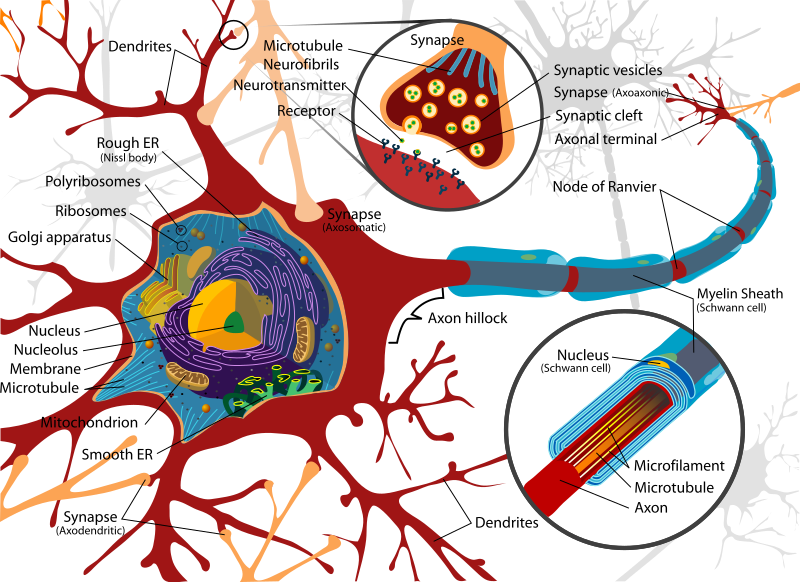Nerve cells and neurotransmitters
Before we explain signaling substances or neurotransmitters, we must explain where they are used in the body. Signaling substances or neurotransmitters are used by nerve cells and brain cells.
A brain cell is also a nerve cell, so for convenience we only use the name 'nerve cell' on this page. The Latin name for nerve cell is neuron. There are as many as 125 billion neurons.
Nerve cell structure
Cell body with a cell nucleus and extensions:
Most neurons consist of:
- a cell body (soma) with a cell nucleus (nucleus)
- a long extension, the axon.
- several small extensions, the dendrites.
Neurites
The collective name for axon and dendrite is 'neurite'.
Axon
Each nerve cell (neuron) has only one axon. It can be compared to a long electricity cable with many end branches.
The axon transmits information as electrical signals (action potentials) from the cell body to other brain cells and to the spinal cord (the central nervous system).
Dendrites
Every nerve cell (neuron) has several dendrites, the extensions of the cell body itself. Dendrite literally means "tree". A dendrite receives information from the body, tissues and from the senses (the peripheral nervous system).
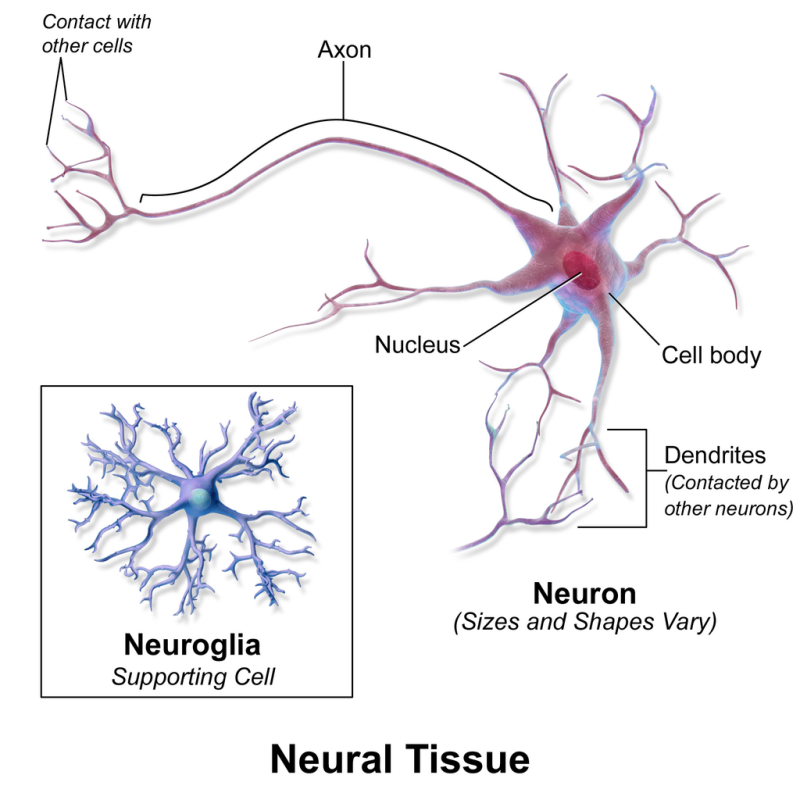
Synapses
The dendrites make contact with the ends of the axons. The synapses are the connection points where the axons and dendrites come together.
Different types of nerve cells
Sensory nerve cells (neurons) send a signal to the central nervous system (brain and spinal cord).
Interneurons send a signal to another nerve cell (neuron) within the central nervous system (brain and spinal cord).
Motoneurons send a signal to muscles and glands.
Gray cells and white matter
The gray matter forms the cortex of the cerebrum (cortex cerebri) and of the cerebellum (cortex cerebelli). The cerebral cortex is really a thin layer of two to six millimeters thick.
Below this lies the white matter with the extensions of the neurons. The fatty protective layer of myelin around the axons gives the white color to the white matter.
Gray matter - receiving information
The function of the gray matter in the brain is to process information.
The gray-brown color is due to the mixture of blood vessels and cell nuclei/nerve cell bodies. It contains:
- dendrites
- short axons
- cell nucleus/cell-body neurons
- supporting cells (glia cells)
White matter - mutual communication
The function of the white matter in the brain is to ensure communication between nerve cells.
The white color is due to the myelin, the fatty covering that ensures electrical conduction. The axon, the long extension of a brain cell, transmits information via action potentials to other brain cells and the spinal cord (the central nervous system).
White matter is composed of:
- long, myelinated extensions of the brain cells; the axons (myelinated with a fatty layer of insulating material)
- astroglia, which are supporting star-shaped support cells. Glia originally means 'neural glue'
- blood vessels
- extracellular matrix,
biological tissue outside the cells that provides support and structure and consists of:
- collagen, elastin, fibrillin, proteoglycans and glycoproteins
- collagen, elastin, fibrillin, proteoglycans and glycoproteins
- myelin sheath, myelin consists of:
- lipids (fatty substance)
- the proteins MBP (myelin basic protein) and PLP (myelin proteolipid protein)
- lipids (fatty substance)
- oligodendrocytes, also a type of glial cell (support cell), which builds the myelin with its many long branches, see image below
- water
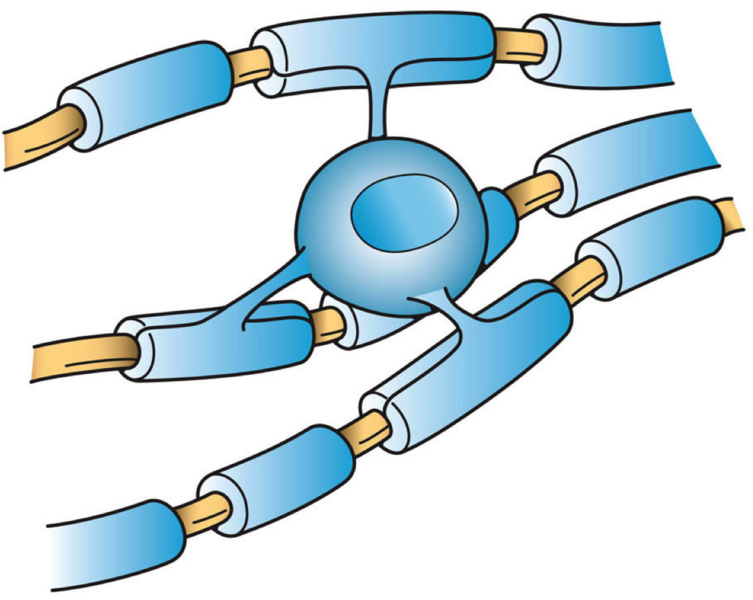
oligodendrocyte
White matter diseases
We have a specific page about white matter abnormalities (WMA)
and diseases and damage in the white matter.
Brain injury fact 1
With brain injury, damage may have occurred in all these parts. An axon, for example, may have been torn off. Brain cells can then no longer communicate with each other or can no longer communicate with muscles and glands.
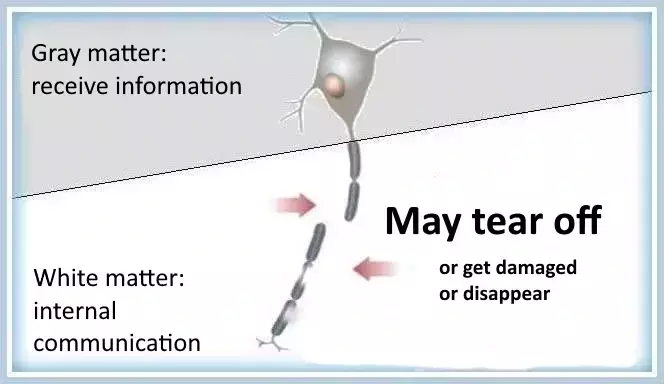
If a cell body is damaged, the entire neuron may die.
The nervous system
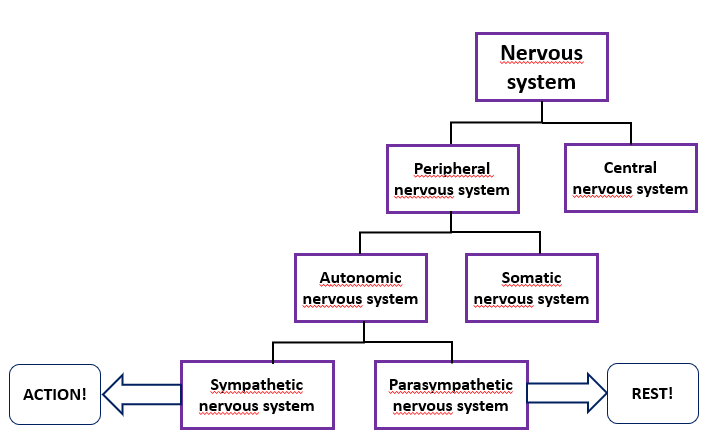
The peripheral nervous system
The peripheral nervous system contains the nerves that run from the brain and spinal cord to other tissues in the body and vice versa.
The peripheral nervous system ensures that:
- signals from your body and senses reach your brain.
- signals from your brain reach your muscles and organs.
The peripheral nervous system has:
- sensory nerves to transmit sensory information to the brain. (pain, heat, cold, and position information)
- motor nerves to transmit information to the muscles.
The autonomic nervous system
The autonomic nervous system is also called the vegetative nervous system. It regulates all automatic functions in the body such as blood pressure, heart rate, breathing and digestion.
Strictly speaking, the autonomic nervous system is part of the peripheral nervous system.
The autonomic nervous system is divided into:
- sympathetic nerves
- parasympathetic nerves
See our special page about the nervous system.
Signaling substances - neurotransmitters
Neurotransmitters are the signaling substances that transmit nerve impulses between nerve cells (neurons) and/or gland cells and muscle cells. You could call them messengers consisting of a chemical substance. Every message starts with an electrical signal.
Each nerve cell has a certain electrical charge that is fired when a specific limit is reached. The neurotransmitters are released.
Neurotransmitters are made in the ends (synapse) of a nerve cell and transported towards the cell membrane of the cell extension, the axon. Some of the neurotransmitters are always ready to be secreted and some are stored in small 'pouches' until they can be used.

Nerve cells communicate with each other through a process that is structured in a step-by-step plan. It can be compared to putting the right key in a lock. Only the key that fits (the right neurotransmitter) opens the door to action.
Prepare for transmitting:
1) An electrical signal is made in a transmitting (pre-synaptic) nerve cell.
2) The signal is transmitted over long distances.
Send:
3) Chemical signals (neurotransmitters) are released from the synapse.
4) The neurotransmitters spread through the synaptic cleft. That is the space between two nerve cells.
Receive:
5) The receiving nerve cell is the post-synaptic nerve cell. That is where the neurotransmitters come in.
6) An interaction is initiated with the receptors in the membrane of this nerve cell.
7) start of a number of processes at molecular level.
8) the "message" is converted into an electrical signal.
Prepare for new action:
9) The receptors release the neurotransmitters. These neurotransmitters can then be broken down or reused in the sending (presynaptic) nerve cell.
Support cells (glial cells) and nerve cells work together to prevent too much accumulation of potassium (K+) and neurotransmitters. They aim to maintain a balance. These glial cells are important, among other things, for communication between brain cells.
During sleep, the glial cells shrink slightly, allowing fluid to flow and waste products to be removed. The brain is thus washed clean of waste products.
In the event of an accident to the head, neurotransmitters can be released on the outside of the nerve cells. They are toxic to the nerve cells and therefore it often happens that some brain cells die in the first 24 hours after a head trauma.
Axons can break during traumatic brain injury. This is not always visible on a CT scan or MRI scan. That is usually the case diffuse injury (spread over the head). Read more about this on our Dutch page on explaining brain scans.
Inhibitory and activating neurotransmitters
There are neurotransmitters that stimulate or inhibit the activity of another nerve cell. The main stimulatory neurotransmitter is glutamate. The main inhibitor is GABA.
Glycine
Acts as an inhibitory neurotransmitter. Used primarily by neurons in the spinal cord.
Norepinephrine
Is both a neurotransmitter and a hormone. Part of the fight or flight system. It usually has an excitatory effect, but sometimes has an inhibitory effect.
GABA (Gamma amino butyric acid)
GABA is the main inhibitory neurotransmitter. It dampens brain activity. It can cause drowsiness and fatigue. GABA is produced from glutamate. Stress-related messages are blocked by GABA.
Glutamate
Glutamate is the most common excitatory neurotransmitter. Almost all excitatory neurons are glutamergic.
Serotonin
Serotonin is involved in many functions, including mood and sensory perception. In the spinal cord, serotonin has an inhibitory effect on pain.
Acetylcholine
Acetylcholine is used by the spinal cord to control muscles. It is used in the brain for memory regulation. It functions as an excitatory neurotransmitter. It is also the neurotransmitter of the parasympathetic nervous system, which ensures relaxation and recovery of the body.
Dopamine
Produces feelings of pleasure when released by the brain's reward system. It usually has an inhibitory effect. In Parkinson's disease
too little dopamine is produced. And the cells that make and use dopamine in the brain, dopaminergic neurons, die from Parkinson's disease.
Dopamine is an important neurotransmitter and is made in the upper part of the brainstem, in the midbrain (mesencephalon). In terms of function, the mesencephalon is considered part of the basal ganglia.
The basal ganglia is formed by important brain structures for initiating movement. The nerve pathways (the connections) between the frontal cerebral cortex and the basal ganglia are sensitive to dopamine.
Dopamine, for example, is necessary for proper muscle control. Dopamine gives a nice feeling when it is released, for example after exertion, exercise, a difficult task, etc. It also works to motivate and influences cognition, attention, learning abilities, memory and sleep.
Norepinephrine
Norepinephrine is the neurotransmitter of the sympathetic nervous system.
Endorphins
Endorphin is a neurotransmitter with a pain-relieving effect.
Medicines or substances that inhibit or stimulate neurotransmitters
There are substances and medications that can stimulate or inhibit the action of a neurotransmitter.
Agonists are substances that stimulate the action of a neurotransmitter. Antagonists are substances that inhibit the action of neurotransmitters.
